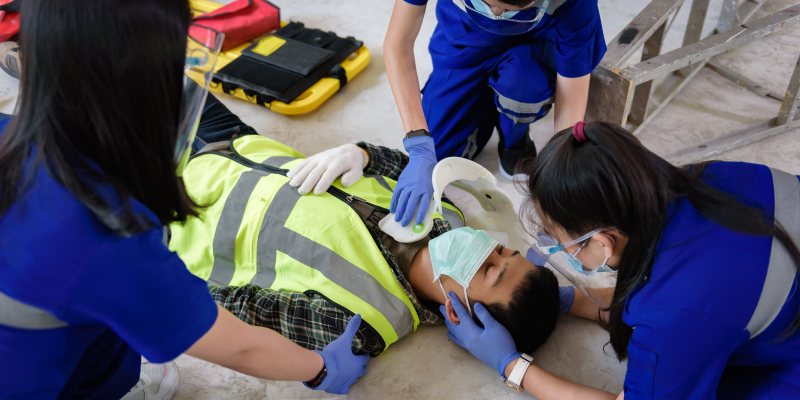
Head and neck injuries are very common during emergency calls, particularly following a vehicle crash, fall, or another trauma that affects the upper portion of a patient’s body. Those who suffer such injuries, beyond the potential for long-term skeletal, muscular, or neurological issues, also carry a high risk for a range of airway issues or crises. If a responder is not able to resolve these issues promptly, the consequences can be fatal.
Providers must therefore remain aware of the significant airway risks posed by head and neck injuries and learn how to address them using safe and effective airway management techniques and tools.
Movement and body positioning
Perhaps the most important aspect of treating someone who has a head and/or neck injury is ensuring you or the patient does not cause any further harm. This can easily occur with excess movement or poor positioning.
Injuries to these areas have a higher likelihood of impacting the spine, so the patient must be fully immobilized. Assistance from a fellow responder is critical in these moments. One of you can focus on preparing to treat the airway and other traumas, while the other can maintain the patient’s position and proper C-spine alignment (in the event of a suspected cervical spine injury). Also, utilize the jaw-thrust maneuver when opening the airway.
Intracranial pressure
A traumatic head injury that also impacts the brain can cause increased intracranial pressure (ICP), an extremely dangerous condition that requires immediate attention. Patients with this condition frequently have a headache, blurred vision, vomiting, altered behavior, weakness or issues moving, and a lack of energy.
ICP may be difficult for an EMT to diagnose, but if it is suspected, responders must protect the patient’s airway, breathing, and circulation to maintain an oxygen supply to the brain. ICP can occur suddenly, so quick and effective action can save a life.
Respiratory distress and failure
A thorough, yet efficient, assessment is key when beginning to treat a patient during an emergency, regardless of a head or neck injury, although it is crucial in these instances. When it comes to airway management, a responder must recognize the signs of respiratory distress:
- Decreased level of consciousness
- Inability to maintain respiratory effort
- Cyanosis.
Additionally, stay alert for signs of respiratory failure and be prepared to intubate. Signs of failure include:
- Altered mental status, which may also be caused by the head trauma
- Retractions or use of accessory muscles
- Tachycardia >130 bpm
- Decreased O2 saturation, even with oxygen therapy
- Pale skin and diaphoresis
- Absent breath sounds
- Cyanosis
- Abnormal respiratory patterns
Airway obstructions
A common airway emergency stemming from the head or neck is an obstructed airway. This may occur from a relaxed tongue (often seen in unconscious patients), excessive bleeding, vomiting (a common concussion symptom), a larger object lodged in the esophagus, swelling, or a damaged or collapsed airway. Additionally, someone with a traumatic brain or spinal cord injury may be physically unable to clear their airway.
Therefore, a visual assessment of the airway is also necessary when arriving at a trauma emergency or when a patient is showing respiratory symptoms. In several circumstances where an airway obstruction is present, suctioning from a portable suction device and, possibly, intubation will be required.
Airway management protocols and techniques
EMS providers and other medical professionals often rely on different forms of airway suctioning, including nasotracheal and oropharyngeal suctioning, for routine or emergency solutions to airway problems. Along with mitigating obstructions, providers perform emergency suctioning when a patient is hypoxic (suffering from inadequate oxygen levels), in respiratory distress, actively aspirating, or experiencing another medical emergency that makes it difficult to breathe or clear airway secretions.
The power level of the suctioning performed and the size of the catheter used should vary depending on the patient. Pediatric and geriatric patients, for example, typically require less suctioning power and a gentler hand.
The key to treating a head-injured patient, however, is maintaining adequate oxygenation and perfusion to the brain, which again begins with a clear airway to allow for sufficient respiration. Intubation is often needed to facilitate that goal, and suctioning before and during the procedure is vital to ensure it goes smoothly. Consider using the SALAD technique to make for more effective intubation and lower the morbidity and mortality rates associated with aspiration and related syndromes that can increase with head and neck injuries.
Understand the Risks and Remain Prepared
Head and neck injuries are dangerous forms of trauma that often result in difficult airway complications for patients, both during and even after the immediate treatment. Providers at all levels must understand the severity of the risks associated with these injuries and always remain prepared to identify and address airway complications using appropriate management protocols. Read this blog to learn more about emergency intubation and suctioning.
Editor's Note: This blog was originally published in February, 2023. It has been re-published with additional up to date content.
















